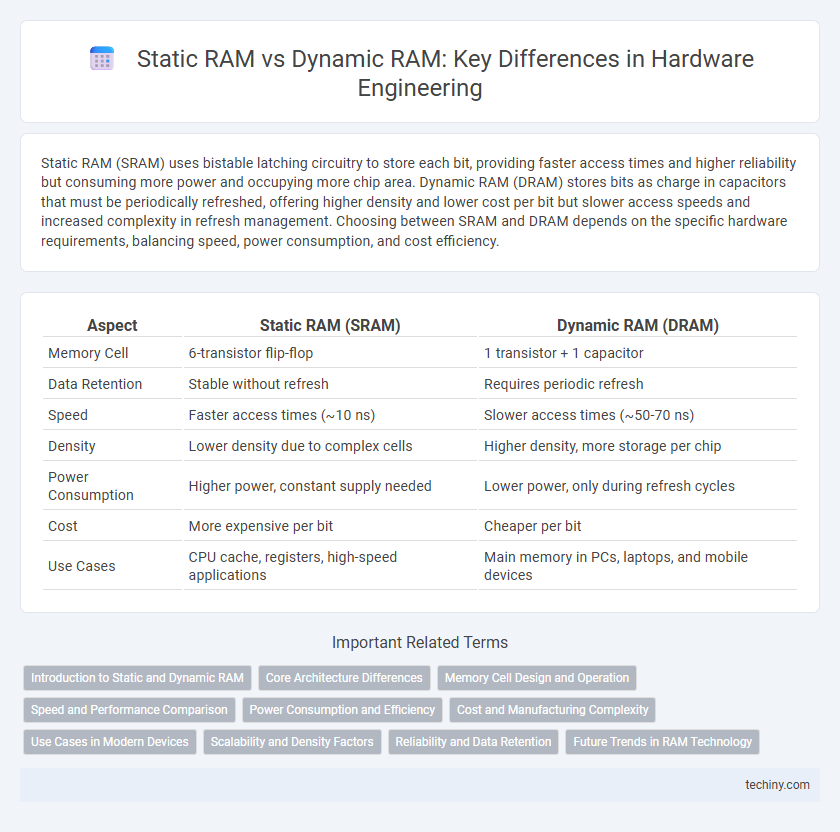Static RAM (SRAM) uses bistable latching circuitry to store each bit, providing faster access times and higher reliability but consuming more power and occupying more chip area. Dynamic RAM (DRAM) stores bits as charge in capacitors that must be periodically refreshed, offering higher density and lower cost per bit but slower access speeds and increased complexity in refresh management. Choosing between SRAM and DRAM depends on the specific hardware requirements, balancing speed, power consumption, and cost efficiency.
Table of Comparison
| Aspect | Static RAM (SRAM) | Dynamic RAM (DRAM) |
|---|---|---|
| Memory Cell | 6-transistor flip-flop | 1 transistor + 1 capacitor |
| Data Retention | Stable without refresh | Requires periodic refresh |
| Speed | Faster access times (~10 ns) | Slower access times (~50-70 ns) |
| Density | Lower density due to complex cells | Higher density, more storage per chip |
| Power Consumption | Higher power, constant supply needed | Lower power, only during refresh cycles |
| Cost | More expensive per bit | Cheaper per bit |
| Use Cases | CPU cache, registers, high-speed applications | Main memory in PCs, laptops, and mobile devices |
Introduction to Static and Dynamic RAM
Static RAM (SRAM) uses flip-flop circuits to store each bit, resulting in faster access times and greater stability without the need for constant refreshing. Dynamic RAM (DRAM) stores bits as charge in capacitors, requiring periodic refresh cycles to maintain data integrity but offering higher density and lower cost per bit. Key distinctions in speed, power consumption, and complexity make SRAM suitable for cache memory, while DRAM is preferred for main system memory.
Core Architecture Differences
Static RAM (SRAM) uses bistable latching circuitry composed of flip-flops to store each bit, enabling faster access speeds and lower latency. Dynamic RAM (DRAM) stores bits as charge in capacitors, requiring periodic refreshing due to charge leakage, which complicates its controller design but allows higher density and lower cost. The core architectural difference lies in SRAM's use of six transistors per bit for stability versus DRAM's single transistor-capacitor pair per bit for compactness.
Memory Cell Design and Operation
Static RAM (SRAM) uses bistable flip-flop circuits to store each bit, allowing fast access times and stable data retention without the need for refresh cycles. Dynamic RAM (DRAM) stores data as charge on a capacitor within each memory cell, requiring periodic refresh operations to maintain data integrity due to charge leakage. SRAM memory cell design relies on multiple transistors to maintain state, whereas DRAM utilizes a single transistor-capacitor pair per cell, resulting in higher density but slower access speeds.
Speed and Performance Comparison
Static RAM (SRAM) offers faster access times and lower latency compared to Dynamic RAM (DRAM), making it ideal for cache memory in processors where speed is critical. While DRAM provides higher density and greater storage capacity at a lower cost, its need for periodic refresh cycles results in slower overall performance. The absence of refresh cycles in SRAM enables consistent high-speed data retrieval, significantly enhancing CPU performance in real-time applications.
Power Consumption and Efficiency
Static RAM (SRAM) consumes more power due to its continuous power requirement to maintain data, but it offers faster access times and higher efficiency in high-speed cache applications. Dynamic RAM (DRAM) uses less power by periodically refreshing data, making it more energy-efficient for large memory arrays despite slower access speeds. Optimizing hardware design involves balancing SRAM's speed and power use against DRAM's energy efficiency and density for specific system requirements.
Cost and Manufacturing Complexity
Static RAM (SRAM) incurs higher manufacturing costs due to its complex transistor design requiring six transistors per bit, resulting in larger chip area and more intricate fabrication processes. Dynamic RAM (DRAM) offers a more cost-effective solution by using a single transistor and capacitor per bit, enabling denser memory arrays and simpler manufacturing with reduced silicon real estate. The trade-off lies in SRAM's faster access times and lower power consumption versus DRAM's higher storage capacity and economic scalability in semiconductor manufacturing.
Use Cases in Modern Devices
Static RAM (SRAM) is primarily used in cache memory and small, high-speed registers within CPUs due to its fast access times and stability without refreshing. Dynamic RAM (DRAM) dominates main system memory in modern devices, offering higher density and lower cost per bit despite the need for constant refreshing. Mobile devices and gaming consoles use SRAM for critical tasks requiring speed, while DRAM handles bulk storage to balance performance and cost efficiency.
Scalability and Density Factors
Static RAM (SRAM) offers faster access times but lower density and scalability compared to Dynamic RAM (DRAM), which provides higher density by storing data as charge in capacitors. DRAM's scalability is enhanced through simpler cell design and smaller transistor counts, enabling greater memory capacity in a given chip area. SRAM, however, is preferred in cache memory where speed outweighs density due to its complexity and larger cell sizes.
Reliability and Data Retention
Static RAM (SRAM) offers higher reliability and faster access times due to its ability to retain data as long as power is supplied, eliminating the need for periodic refreshing. Dynamic RAM (DRAM) requires constant refreshing to maintain data integrity, which can introduce temporary errors and reduce overall reliability. The inherent design of SRAM cells using bistable latches provides superior stability for critical applications, while DRAM's capacitor-based storage is more prone to data loss, impacting data retention under power fluctuations.
Future Trends in RAM Technology
Future trends in RAM technology emphasize the evolution of dynamic RAM (DRAM) towards higher density and lower power consumption through advancements like 3D-stacked architectures and novel materials such as graphene. Static RAM (SRAM) continues to see improvements in speed and reliability, driven by developments in CMOS technology and emerging alternatives like Magnetoresistive RAM (MRAM) for non-volatile applications. Increasing demand for energy-efficient, high-performance memory in AI and edge computing is accelerating the integration of hybrid memory systems combining the strengths of both SRAM and DRAM.
Static vs Dynamic RAM Infographic

 techiny.com
techiny.com